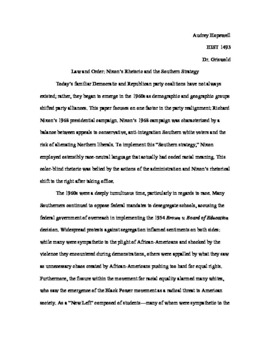| dc.creator | Hopewell, Audrey | |
| dc.date.accessioned | 2017-08-01T00:49:55Z | |
| dc.date.accessioned | 2021-04-14T15:26:31Z | |
| dc.date.available | 2017-08-01T00:49:55Z | |
| dc.date.available | 2021-04-14T15:26:31Z | |
| dc.identifier.uri | https://hdl.handle.net/11244.46/1282 | |
| dc.description | David W. Levy Prize finalist, Spring 2017 | |
| dc.description.abstract | Today's familiar Democratic and Republican party coalitions have not always existed; rather, they began to emerge in the 1960s as demographic and geographic groups shifted party alliances. This paper focuses on one factor in the party realignment: Richard Nixon's 1968 presidential campaign. Nixon's 1968 campaign was characterized by a balance between appeals to conservative, anti-integration Southern white voters and the risk of alienating Northern liberals. To implement this "Southern strategy," Nixon employed ostensibly race-neutral language that actually had coded racial meaning. This color-blind rhetoric was belied by the actions of the administration and Nixon's rhetorical shift to the right after taking office. | |
| dc.format.extent | 26,759 bytes | |
| dc.format.medium | application/msword | |
| dc.relation.requires | Microsoft Word | |
| dc.subject | Presidents -- United States -- Election -- 1968 | |
| dc.subject | Nixon, Richard M. (Richard Milhous), 1913-1994 | |
| dc.subject | United States -- Race relations -- Political aspects | |
| dc.subject | David W. Levy Prize | |
| dc.title | Law and order : Nixon's rhetoric and the Southern strategy | |
| dc.type | Document | |
| dc.type | text | |
| dc.contributor.sponsor | Myers, Leroy | |
| dc.contributor.sponsor | Griswold, Robert | |
| dc.description.undergraduate | undergraduate | |
